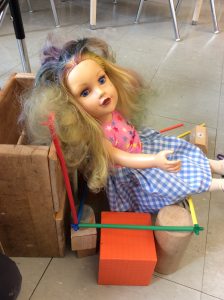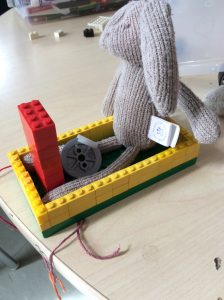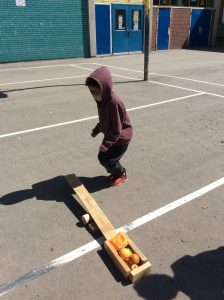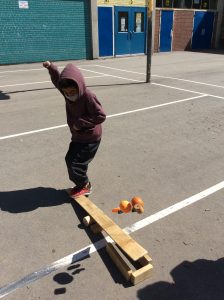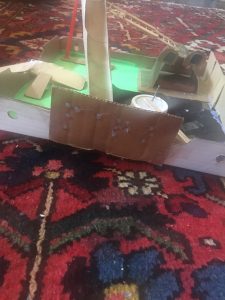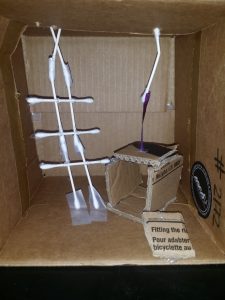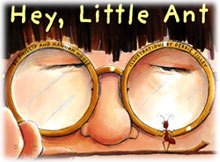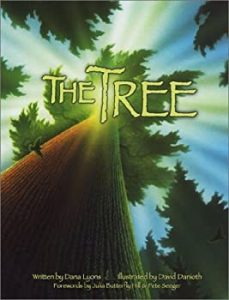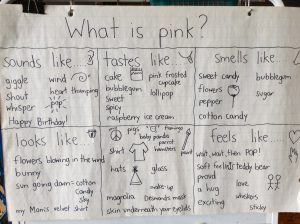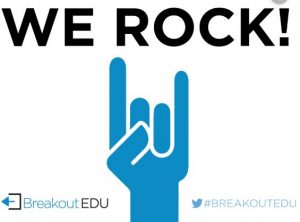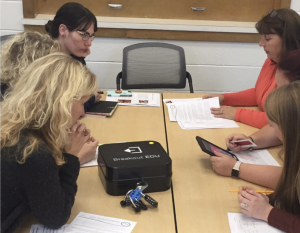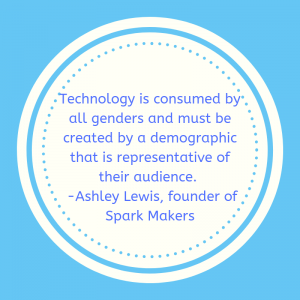I was very disappointed to learn that we would not be returning to school in June. I am missing the students and their families. I feel isolated from my co-workers, and I am longing for the times when we would connect in the hallway and out in the yard. I do not love teaching on-line, but I am finding new ways to engage with my students, collaborate and play.
Reader’s Theatre:
Reader’s Theatre and/or writing and performing original plays works really well on-line. With younger students, you can share the screen and read a poem or a play together as a shared reading activity. Older students can work in Break-Out rooms (ZOOM) or in their own meetings to write and/or read together. To support the creative process, there are several Drama games and conventions that work on-line, such as speaking in-role, Mirror, exploring different feelings through movement and facial expressions, charades, and more!
It’s Show Time!
As we have all discovered, there is something extra performative about staring at yourself while you are teaching. There are times when I feel like a Children’s Television Host, trying to be as animated and entertaining as possible, which can be exhausting. My students need a body break every 30 minutes, so I always join them to jump and dance to various fitness videos. I have seen educators on social media upload photos of themselves in costumes, sharing ideas about themes such as Beach Day and Star Wars Day. We are all working so hard to be creative and keep our students happy. We deserve a standing ovation every day!!
In preparation for Earth Day, we listened to the story “The Great Kapok Tree” by Lynne Cherry. When a Kapok tree in the Amazon rainforest is threatened, different animals who depend on the tree speak out. All year, we have been learning about relationships, and the ways in which humans and more-than-humans are all related and connected. This book also supports the Science learning in Grade 2 for Growth and Changes in Animals, as well as environmental justice. I found a Reader’s Theatre script on-line shared by another educator, which I was able to revise for my own students.
Puppets!
Puppets can be used very effectively to tell stories on-line. After choosing their parts, everyone was encouraged to think about how they might develop their character using voice and movement. One of the students’ in the class has two parents who are actors. Krystal Meadows and Eli Ham joined us on-line as special guests. They shared ideas about how we could use the “box” that we are in to move in different ways. We imagined how our character might be feeling, and how that might impact the way the character moves and speaks. We learned about pitch (how high and how low), tempo (how fast and how slow), and timbre (the quality of sound). During this rehearsal time, everyone was working at home to make a puppet. Some students used a paper bag, or glued a drawing to a stick. Others used toilet paper rolls or socks. They were all very creative!
“Keep Calm and Break a Leg”
After two weeks, we were ready to share our play. In preparation for our performance, some students created their own art to use as backgrounds, which was lovely. We discovered that virtual backgrounds don’t work because the puppet (and the actor) sometimes disappear. During the performance, students were amazing at muting and unmuting themselves. I encouraged everyone to have their own copy of the script so that we did not have to share the screen. We also used “Speaker View” to focus on who was speaking.
The first time we performed, I recorded the meeting and shared it with families to enjoy. We also watched the recording together as a class. We practiced giving and receiving feedback, and thinking about how we might improve our performance. At the next Staff Meeting, I invited other classes to join us for a second performance. I shared our ZOOM link and we had another chance to share our hard work with a new audience.
One of the advantages of performing on-line is that the audience was able to hear the actors clearly. Without a microphone, it can be challenging in-person, (especially when wearing masks) to be heard on stage. If you have an on-line opportunity to write a play with your students or use Reader’s Theatre to perform poetry or a script, I highly recommend it. Drama is so playful and filled with possibilities. Play on!!
Buiding an Inclusive Playground
I am having a lot of fun learning how to center issues of disability justice and equity throughout the curriculum.
Every week, during MSI (Math-Science Investigations) the Grade 2 students solve problems using a variety of building materials. As part of the Science curriculum, we are learning about Movement and Simple Machines. We started this inquiry when we were face-to-face and finished on-line. We have integrated this learning with disability justice, equity and community activism. For example, we went on a walk and collected data about barriers and “bridges” in our local community. Then, the Grade 2 students designed inclusive playgrounds where everyone is welcome.
Here are some other examples of how we are deepening our understanding of Structures and Mechanisms, and making connections to the local and global community.
World Water Day:
We celebrated World Water Day on March 22, as part of our year-long inquiry about water. Throughout the year, we have explored a variety of texts, including resources from The Junior Water Walker website. After reading “The Water Princess” by Susan Verde and “Anna Carries Water” by Olive Senior, our class simulated the experience of carrying a bucket around the track for 1 km, to represent the journey taken by girls and young women every day. 

Then, we used building materials to investigate: How might you move water from one place to another?
We learned about a simple machine that was invented to help families carry water in rural India. We watched a YouTube video about The Wello Water Wheel, and talked about the impact it might have.

Toy Day:
On Toy Day, the MSI challenge was: Design a structure that moves or helps your toy to move.
Freda made a wheelchair for her doll. Svea made a sled.
After building, we watched this video:
Science Max: Simple Machines
Outdoor Learning:
One day, we collected materials to bring outside to investigate simple machines. We worked with partners to explore: How might you use ramps and different balls to investigate levers and inclined planes?
Before schools went back to on-line learning, we went on a Community Walk. I invited students to think about: “How might we make our community more accessible? What are some of the barriers and “bridges” in our community?” Students worked together to draw, write and collect data on clipboards. We found ramps made by StopGap Foundation, and followed up our walk by reading books about children with different abilities.
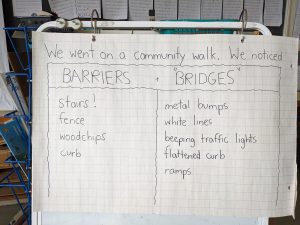
Inclusive Playgrounds:
The summative task was: Design and build a model of an inclusive playground that includes a simple machine. The equipment must move a person up and down, or round and round or back and forth.
Students used a variety of materials to build their inclusive playgrounds, including Lego, recycled materials, clay, and Minecraft. Before building, everyone was encouraged to make a plan and draw their designs. Everyone worked on their project off-line and came together to share their VIP: Very Important Projects at the end of the week.
Clem used a glue gun to spell “PARK” in Braille letters. Avery included an elevator.
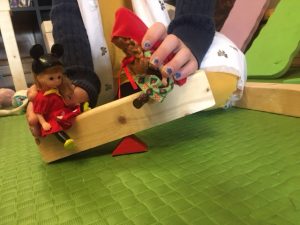

Oral presentations have been an effective way to connect, share ideas and feedback, and assess students’ understanding. Technology/Being on-line has created space to hear each other, share our screens and look at photos of our work up close, and invite others into creative Minecraft worlds. These integrated learning activities were engaging, fun, creative, and provided meaningful opportunities to explore inclusive design and disability justice.
Point of View
This month, we are exploring different points of view through reading and writing a variety of texts. This “big idea” has many possibilities for critical thinking and cross-curricular integration with Media Literacy, Social Studies, Science, Visual Arts, Music and Drama.
In my Grade 2 class, we have used point of view to explore issues of accessibility, anti-Black racism, Indigenous sovereignty and homophobia. Here are some of the texts that Kindergarten-Grade 8 educators can use when learning on-line and in class:
William’s Doll
During Gender Splendour Week, we read “William’s Doll” by Charlotte Zolotov, to explore gender stereotypes and homophobia. We also watched a video from the movie, “Free to Be You and Me” that sings the story as a song. “William’s Doll” is about a boy who wants a doll to play with, but he is told that he cannot have a doll because he is a boy.
Young children receive powerful messages from family, media, clothing and toy stores about what is expected of “boys” and “girls.” These binaries reinforce heterosexism, and often cause harm and exclude students who do not fit into these boxes. It is important to give children the opportunity to name, question, and challenge these gender binaries, and create space for more possibilities.
Before reading “William’s Doll”, I asked students to share their ideas about what it means to be a “boy” and a “girl.” We talked about what a “stereotype” is and how these ideas might not include everyone. Students easily made connections to their own personal experiences of shopping, and described how different products are sorted and sold, (e.g., pink Kinder Eggs for girls). After reading, we used a graphic organizer to support our ideas with evidence from the text. Then, students wrote about different points of view expressed in the text. 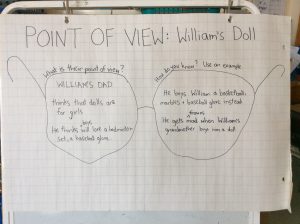
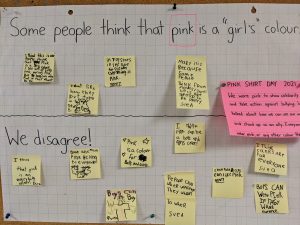
Of Course They Do!
On the International Day of Pink, we continued to have courageous and critical conversations about how schools can be more inclusive, and how we can take action as allies. After reading texts such as, “Of Course They Do! Boys and Girls Can Do Anything” by Marie-Sabine Roger and Anne Sol, and “10,00 Dresses” by Marcus Ewert, students talked about their experiences of being told they couldn’t do something because of their perceived gender. For example, boys with long hair shared their experiences of being challenged in the washroom. We focussed our discussion on how we might respond to questions and/or suggestions that we don’t belong. We used Drama and role-play to practice naming and responding to behaviour.
Hey, Little Ant!
“Hey, Little Ant” by Hannah Hoose and Phillip Hoose, is a story about a kid who is about to squish an ant. The story is told from two different points of view. On each page, we hear the voice of the kid and a response from the ant. The story ends with a question, which is a great prompt for discussion and writing, “What do you think that kid should do?”
This story is a great opportunity to explore empathy and compassion, and students’ relationships with animals. “Hey, Little Ant” also includes a song, which can enrich the text. After reading, students wrote about the different points of view in the story, and then wrote about their own point of view.
The Tree
“The Tree” written by Dana Lyons is written from the point of view of a tree in the Pacific Rainforest. After writing and sharing the story, the author learned from elders of the Lummi Nation, the original inhabitants of San Juan islands, that he has written the tree’s song. Every tree has a song.
We listened to “The Tree,” drew pictures and shared stories about trees that are important to us. Then, students wrote their own poem or song from the point of view of a tree. We used sentence prompts, such as: “I live….” “I hear….” “I have seen….” “My favourite season is…..” “I wonder….” “I hope…” I found a video of Dana Lyons singing the text as a birthday present for Jane Goodall. I hope we will be able to turn our text into songs!
The Council of All Beings
I am always inspired by my teacher friends! Maria Vamvalis is currently working on her PhD, and shares her learning about climate justice with Natural Curiosity as a mentor coach. We took a course together at OISE, and Maria shared how she has used “The Council of All Beings” to allow students to connect with land and speak in-role from the point of view of other life forms, including animal, plant or natural feature, (desert, forest, etc). This article written by Joanna Macy describes the process.
I am learning that the purpose of the Council is to listen and give voice to land, which includes animals, plants, air, water, soil, etc. The process honours our shared responsibilities and relationships with more-than-humans, and helps us to remember and reconnect with land. It requires guidance and thoughtful facilitation. It sounds like a powerful teaching and learning experience.
Joanna Macy explains: “The Council unfolds in three consecutive stages. First, the beings address each other, telling of the changes and hardships they have experienced.” The second stage creates space for humans to hear from the more-than human beings directly. A few students remove their mask and are invited into the centre of the Circle to listen. The third stage of the council involves the other beings offering gifts to the humans. “As ritual guide I might cue this stage by saying, “Many humans now realize the destruction they are causing; they feel overwhelmed and powerless in the face of the forces they have unleashed. Yet our fate is in their hands. O fellow-beings, what strengths of ours can we share with them, what powers can we lend them?” With this invitation, the beings in the Council begin spontaneously to offer their own particular qualities and capacities. After speaking, each leaves their mask and steps in the centre as humans to receive gratitude and gifts. There is opportunity for singing, dancing and release, as well as reflection and stillness.
I think “The Council of All Beings” would enrich any Earth Day celebrations, and/or National Indigenous Peoples Day. I believe it could be adapted for on-line learning, and would be a powerful collaborative and creative experience for all members of the school community, including families.
People’s Tribunal on the Coronavirus Pandemic
I have a new subscription to “Rethinking Schools”, which is an excellent magazine about social justice education. In the Winter 2020-2021 issue, Caneisha Mills describes how she organized a tribunal with her Intermediate students to explore responsibility for the COVID-19 crisis in the United States. Some of those on trial include: Mother Nature, Racism, the HealthCare industry, Capitalism, and the U.S. government. You can read the article, “Who’s to Blame?” here.
Caneisha Mills honours student voice and engages students in a collaborative and critical process of exploring the global pandemic from different points of view. She honours student voice, and creates a brave space for students to “grapple with profound social injustice” and imagine different possibilities. Mills explains that the “most important part of this lesson involves students writing a 10-point program — inspired by the Black Panthers’ 10-point program, adopted in 1966 — on how to prevent crises like this in the future.”
The article includes a clear teaching plan and provides information for educators who might want to implement the People’s Tribunal on the Coronavirus, on or off-line. “This people’s tribunal begins with the premise that a heinous crime is being committed as tens of millions of people’s lives are in danger due to the outbreak of the novel coronavirus — COVID-19. But who — and/or what — was responsible for this crime? Who should be held accountable for the spread of the virus and its devastating impact?”
The teacher plays the role of the prosecutor. Students are assigned different roles, and the “defendants” are supported to work in small groups to develop a defense against the charges outlined in the indictments. A jury is selected, and each group shares their arguments at the trial. There is only one rule: They may plead guilty, but they must accuse at least one other defendant of being responsible. After the jury deliberates and explains their verdict, all students are invited to reflect on the experience. Then, they use their voice to demand and create change.
The tribunal sounds like a meaningful learning opportunity for older students to explore different points of view. I am curious to think about how this might be adapted for younger students.
In your point of view, what are some powerful texts and/or dramatic conventions that you have used in the classroom and on-line? Please add them to the Comments below.
“Breathe-in experience, breathe-out poetry.” M. Rukeyser
April is National Poetry Month.
During this challenging year, poetry has supported critical and courageous conversations, offered some comfort and hope, while honouring pain and anger. Here are some examples of what this work has looked like and sounded like in our Grade 2 classroom:
Igniting the Spark: Amanda Gorman
The whole world was inspired by the poetry and brilliance of Amanda Gorman in January 2021. Her poem, “The Hill We Climb” filled us with light during this time of “never-ending shade”. Her story about overcoming a speech impairment reminded us all to believe in ourselves and find our voice. I shared her poem and her TEDTalk with my students, and she was the spark for our inquiry about the power and possibilities of poetry.
Power Poems for Small Humans:
I have reached for poems during difficult times when I could not find the words to express my feelings. Jillian Christmas is a Vancouver-based slam-poet, who is an organizer and activist in the arts community. I have shared her poem, “On Honouring Anger” in response to racial violence and injustice that continues to impact students, staff and families, and requires educators to take action.
This poem, and other powerful voices can be found in an anthology called “Power Poems for Small Humans”, published by Flamingo Rampant. Flamingo Rampant is a micro-press that publishes children’s books that center and celebrate stories of kids taking action, disability pride, 2SLGBTQ+ voices, racial justice and more. Please check out their website and bring their books into your classroom library!
Yesterday, I Had The Blues:
When we were learning remotely, I used the Poll feature on ZOOM to check-in with students. One day, the question was: “How are you feeling today? Choose a colour to describe how you are feeling.” Students were invited to analyse the data, and share why they chose the colour. Then, we talked about different ways that people experience colour. We listened to the story, “Yesterday, I Had the Blues” by Jeron Ashford Frame, and made text-to-self connections.
Next, we read selected poems from “Hailstones and Halibut Bones” by Mary O’Neill. I love this book, but it is important to preview the poems, because there is one poem that uses outdated language, and needs to be unpacked or revised. Each poem begins with the same question, (e.g. What is Orange?) and uses the five senses to describe colour in poetic ways. I created a graphic organizer, and students were invited to write their own Colour Poems.
Pink!
On the International Day of Pink, we had a discussion about how some people think that pink is a “girl’s colour.” We talked about where these ideas come from, and how these gender rules might make people feel excluded. We created a poster using post-it notes to capture our ideas, in the style of a JAMBoard. Then, we wrote our own “What is Pink?” poems and displayed them in the hallway.
Quick as a Cricket:
After reading, “Quick as a Cricket” by Audrey Wood, students wrote poems using the template, “I’m as ____________as a ___________.” This was a fun and accessible way to learn about the poetic device of similes. A simile compares two different things using “like” or “as” in an interesting or unexpected way.
Gratitude Poems:
After reading several poems from a collection called “ThankU: Poems of Gratitude”, we wrote our own “Dear Water,” poems. Students used the following sentence prompts to write a letter to our relative: “I love….I think….I will….I hope….You are….” On World Water Day, we read our letters to each other in the Rainbow Garden and talked about what we value, and how we might protect water.

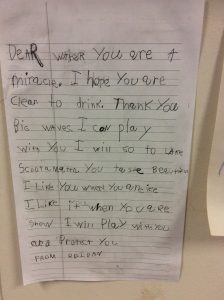
Splish! Splash! Splat!
One rainy day, we brainstormed different sounds that water makes. Then, we learned about Concrete poems, which are poems that take the shape of the subject that they are describing. Students chose a shape and wrote a poem about water.
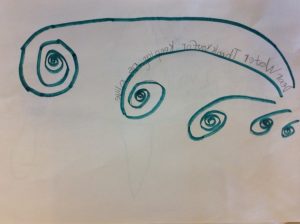
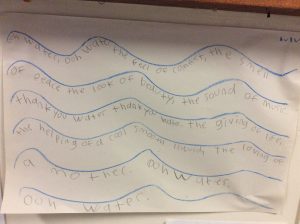
Respond and Rebuild:
We will continue to explore poetry, self-expression and identity by writing an “I am Me….” poem. This lesson plan is from www.welcomingschools.org and can also be found in ETFO’s newest resource, Respond and Rebuild CRRP Lesson Plans. I am looking forward to integrating movement and choral reading to this work.
What are your favourite poems or poets to explore in the classroom?
“Techie People”
As someone who is passionate and truly geeky about the power of technology in education, I often hear from my fellow teachers, “I’m not really a techie person.” Now, I get where they are coming from because technology can be intimidating. Many times I’ve said, “I’m not really a math person.” I can “do” math and I can “learn” math but it doesn’t get me fired up quite like tech does. However, over the last few months educators who weren’t really “techie people” didn’t have much of a choice other than to use tech in order to do their job. I cannot imagine what that must have felt like for some educators. For some educators, it must have been terrifying. For me, it would have been like my Principal saying that I was now the new math consultant for the intermediate grades. It would have caused me serious panic and anxiety. I probably would have considered resigning but I would have dug in and done the best I could with the tools available to me and I would have reached out to fellow colleagues and leaned on their expertise. THAT is what teachers all over the province of Ontario were doing after the March Break, teaching and learning by the seat of their pants.
As an innovations consultant what I witnessed during the weeks of distance learning was fellow educators doing what they do best; rolling up their sleeves, getting in there and figuring the tech stuff out. As I (along with some fantastic and enthusiastic educators in my board) provided webinar workshops on technological tools for teachers, I saw teachers who were self proclaimed Luddites attending and showing appreciation for what we were doing. The resiliency of educators during this time has been absolutely amazing. The necessity of teaching through technology broke through an invisible barrier that has existed for those teachers who thought that you had to be a “techie person” in order to use tech in education. Teachers were no longer afraid to try a new technological tool, to make mistakes and ask questions. Teachers are discovering the power educational technology and they’ve been bit by the tech bug. Educators will always continue to seek out new and innovative ways to deliver curriculum to students and learn as they go-no matter how steep the learning curve. Some teachers who would have quickly proclaimed, “I’m not a techie person” before March Break are now excited about the possibilities of using technology even in their face-to-face classrooms. The Educational Technology Geek Community is over-the-moon excited about increasing it’s membership! We are a friendly bunch, inclusive, sharing and passionate and we’re happy to help.
Looking on the bright-side during this dark time.
During this time at home, we are all probably having positive and negative learning moments. From seeing students thrive for the first time to having zero assignments turned in, the highs and lows have been a rollercoaster over the past few months. However, during this time for my sanity, I need to focus on the positive ones. I would love to share a few from my experience teaching grade eight online.
- Removing student anxiety: Many of my students have had a hard time in the classroom this year due to certain factors that make them extremely anxious. Attendance issues have made it hard for some of them to learn this year and that has always been something I have struggled with, how to reach the students who do not attend. Even the students who do attend have anxiety issues related to noise in the room, other students bothering them or starting the day in a terrible mood. My class is super respectful so I always had a hard time understanding what the exact factors were, but I came to realize it was just a feeling they carried with them and could not be easily fixed. With online learning, these students have submitted work daily and have been involved on our online teams meetings. They have been thriving in this environment and for the first time, I am learning so much about how intelligent they are and how much they have to share. The online platform has given them a voice and a chance to accomplish things.
- Reaching all learners: Now that the school day exists at all times, I can answer all questions at once without there being a physical line up or a limit on the amount of students I can help. When someone online needs help, I can help them right away as the odds that another student needs help at that exact moment is slim. Although my students are working at all hours of the day, I had informed them that I would be available (virtually) from 9-3 everyday. They keep their questions for the most part within these hours and I love that I can respond to them right away. Also, I am able to help students via platforms that work for them and I am so thankful that my students have downloaded all of the new apps that have been made available to us.
- Continued differentiation in a new and unique way: With the help of google classroom, I can assign specific work to every student at the click of a button. I can modify every assignment and make special ones for my students that go directly to their google drive. When creating an assignment or learning material, I can tailor the assignment to how they want to learn, what they want to learn and give it directly to them. I was already doing this in the classroom but I am happy I can continue to do it online. I was nervous about assigning work online and how I could make it specific to students so with google classroom I was happy to see it was an easy process. Then, once my students finish an assignment, I can assign them more work at their own pace. Right now I have students completing work at 25 different rates and I need to be able to keep track of what they have/have not done. Google classroom allows me to look at what they have handed in and then direct them to the next assignment.
- Small groups style learning: My favourite thing about teaching online is creating small groups live meetings. We have been using the apps “Teams” by Microsoft and it was has been an amazing way to teach in small and medium sized groups. Every Tuesday, I have a live math/literacy class with my students. I invite all of them but usually I only get half the class. From there, I create smaller groups to teach them the topics that they still need help with or to move them ahead in the unit. I also have a meeting on Wednesdays with my ESL students where we read a book and answer questions together. We also work on math topics and play simple word games. On Thursdays, all of the other grade eights meet together to play games and reminisce about the year. This Thursday, they will be sharing their favourite writing piece from the year and will be sharing to their classmates their strengths as a writer. Small groups is something I had done in the classroom but online now more than ever I have implemented small groups in a way that really reaches all learners. I really hope to bring that into the classroom at a new level more successful than ever before. That is my favourite success from the online learning environment.
Although there are days when I feel like I may be posting to no one, I know that there must be students who are benefiting from it. The online meetings have been such a blessing during this time as hearing their voices always remind me of how special this profession is and how lucky we are to have technology to help us through this time. I am desperately looking forward to the day where we can teach in the classroom again but for now, I am happy to have these successes to think on and to reflect about how they will make me a better educator. I hope everyone else has some moments that they can look at and reflect positively on.
Overwhelming Resources
As we engage in distance/remote/online/emergency learning Educators are being inundated with resources and tools to use in their virtual classrooms. It isn’t easy to decide which would be most effective and which ones are safe for teachers and students to use. There is no one size fits all answer to this but there are a few things that I do in order to narrow down my choices of whether or not to use a particular digital tool or resource:
- I search for tools that are designed by Canadian or better yet, Ontario Educators and where possible, data is housed in Canada.
- I look at whether or not the tool will still be free after the COVID crisis is over or whether it has always been a free tool. I honestly don’t mind paying for a tool from the outset but I don’t really like the whole free trial thing. I also don’t want to pay some kind of a monthly fee. One time price, please! I don’t want to love a tool so much while it is free and then have to pay for it when I go back into the classroom.
- I look at whether or not it is a one time fee or negative billing. I won’t give anyone my credit card to start a free trial for a tool.
- I search for tools that I know will be supported by my ICT department. Anything that wants access to email contacts in my school board is a non-starter.
- I search for tools that inspire collaboration and creativity. I’m not one to sign up students for a gaming platform that is really just an engaging math drill.
- I look at bang for my buck (even if it is free). Is it a versatile tool? Does it allow for different forms of communication? Can I embed audio and video? Is there an opportunity for a variety of feedback methods?
- I look at the Privacy statement. Although I am no expert in this, I can generally tell when something has red flags. Anything that is attached to third party social media platforms like Facebook is a non starter for me.
- Right now while there are so many sign ups and passwords for students, I stay away from platforms that want to create student accounts and want information apart from an email.
- I look to see if it is a Microsoft or Apple Education certified product? I know that for the most part, those tools are trustworthy.
- I look at user reviews and YouTube tutorials. I want to know what the pitfalls are of something before I invest time and/or money.
At the end of the day no tool is perfect and few tools are unlikely to meet the specific needs of each and every student in your classroom. However, I hope that what I do when choosing a tool might guide you to the most effective tools in the over abundance of resources that are floating around out there.
Mindfulness in Education
There is a significant amount of research about the benefits of mindfulness in education. Much of the research shows that consistent mindfulness practices in classrooms lead to lower stress levels and higher test scores. It is a hot topic and wanting to to do the best for students, we are seeing more of it in schools. There are all kinds of books and videos on breathing and mindfulness exercises for reduction of stress for kids. I have learned to practice meditation myself and I have used some mindful practices with my students and believe that at the right time and in the right circumstance mindfulness practices can be powerful. I am left wondering, however, if the practice of mindfulness in some cases is becoming routine or something to check off on a plan and not truly ‘mindful’ at all?
Let’s take yoga for example. Yoga instructors go through intense hours of study in order to practice and teach others. However, teachers pop on a kids yoga YouTube video and we’re “being mindful”. I’m not being critical. I have done it myself! My question or wondering is; what are the implications of these actions on a broader level? Yoga is about mind and body. My worry is that we are literally “going through the motions” with students and not really giving them a true mindful experience.
How about a timed meditation? Everyone drop everything and take part in a guided meditation right now! I understand the idea behind this strategy; the whole school is engaging in the practice at the same time. However, isn’t the idea that students will learn to develop mindfulness skills to help them in stressful situations? It is a starting place, but hopefully there is more in-depth practice and explicit teaching happening. Otherwise isn’t it more a kind of fast-food approach to mindfulness?
Mindfulness needs to have an environment that is conducive to practice. Norms and expectations need to be established and there has to be “buy in” from the students. Students require a variety of skills in order to truly practice mindfulness and they need to be explicitly taught so that students can use what they know in order to transfer the knowledge into other situations. Finally, it has to be modeled by the adults in the room. If there is mindfulness being practiced, everyone should be doing it and debriefing the experience and learning together. If a teacher is busy organizing the classroom library while the students are being mindful, it won’t demonstrate that mindfulness is valued.
We can’t be experts at everything. We can’t always have a certified yoga teacher come into our classroom. Whatever we are teaching it must be done with intention, done explicitly and through modeling. Going through the motions out of habit and routine may do more harm than good.
Breakout EDU
Breakout EDU is like an Escape Room in a box. The players use teamwork and critical thinking to solve a series of challenging puzzles in order to open a locked box. The first time I experienced Breakout EDU with my students I was not the designer of the game. Another teacher had designed the Breakouts and we were using it as a provocation for an inquiry on the Olympics. I was amazed at how much I wanted to help my students. It was difficult to watch them struggle and yet, that is where the learning happens. We want our students to BE “gritty” and we need to provide opportunities for students to develop that grit. Breakout EDU is a great way in which to have the students experience “the struggle”. The kit looks like this:
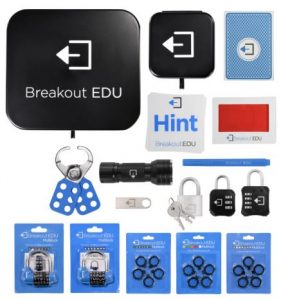 https://www.breakoutedu.com/
https://www.breakoutedu.com/
The kit itself is quite pricey and unless your school already has one, it is quite an investment. However, you can make your own with a tool box and locks purchased from a variety of stores. You can also create online digital Breakouts that create the same kind of collaborative, problem solving activity just without the cool locks. Here is the link to some curated online “digital” breakouts. I haven’t looked at all of these for curriculum alignment, but it will give you some ideas to use to create your own digital breakouts.
“Breakout” is sort of a misnomer. You are actually “breaking in” to the box using a number of clues students solve puzzles in order to open the various word, number and key locks. This can connect to the curriculum in a number of different ways and can be used effectively as an introduction, provocation or summary for learning. You aren’t going to get too terribly deep into content when students are busy trying to solve for clues. For me, Breakout EDU is far more about developing the 6 C’s; collaboration, creativity, critical thinking, communication, citizenship and character building. It is fascinating to have students work in groups to solve problems with a common goal. Breakout EDUs provide opportunities for students to practice developing their learning skills and gives the teacher the opportunity to collect data as the learning is self-directed. The activities lead easily into self-reflection of learning skills. Below are some of the questions that I find valuable for the consolidation portion of a lesson after a Breakout EDU activity:
Questions for Reflection
1. How did you determine roles in your group?
2. What did you find most difficult?
3. What did your group do really well together?
4. What would you do differently next time?
5. How did you contribute to the group?
6. How did you work to include everyone in your group?
Once students are familiar with the Breakout EDU format (depending on the age/grade level) they can then create their own Breakouts for their classmates. The students interact with the learning from a different perspective and have to find the most important information to highlight for the clues in the development of the Breakout.
So what are the drawbacks? Breakout EDU is competitive. The students are working against each other and/or against the clock. You have to know which students can handle that type of pressure. Working in groups on a common task may be difficult for some students with self-regulation issues so you have to know your students well and plan accordingly, as you would for any group activity.
Finally, Breakout EDU is also a great tool to use with your staff. If you have a lot of information to get through and you want the participants to get to some salient points and the Google Slide presentation just isn’t cutting it, using a Breakout EDU will make for an interactive, team building staff meeting! It is also great to have the adults experience the struggle that we all want students to go through to develop grit and resilience.
Like with any tool, it takes time and research to ensure that it is right for your classroom. The more I use Breakout EDU in my teaching, the more I think of ways to use it!
The Gender Gap in Technology
According to a recent report* by ICTC (the Information and Technology Information Council) Canadian women represent about 50% of the overall workforce but represent only 25% of the technology industry workforce. Of the 100 major tech companies in Canada only 5 have female CEOs and 1 Co-CEO. 26% of the tech companies have no women in senior leadership at all. There is a gender wage gap in the industry of $7,000-$20,00 per year. When I read these statistics I wondered as educators, what can we do about the gender gap in technology? This is not an exhaustive list, but it is a place to begin:
1. Build her confidence in her abilities.
2. Cultivate a community of supportive peers.
3. Provide a STEM/STEAM club for girls.
4. Ensure that access to technology and computer experiences is encouraged and inclusive.
5. Foster interest in computing careers.
6. Be a role model as a LEARNER.
May 11th is National Girls Learning Code Day. If you are looking to encourage coders in your school, why not begin on May 11th? Below you will find links to resources for beginning coding. Many students code on their own at home and may appreciate the opportunity to mentor fellow students. The resources attached will get you started. There is no special equipment or robotics required. Teachers do not have to be expert coders to encourage their students. Teachers can be role models of resilience, risk taking and problem solving by learning alongside their students. Teachers only need to open the door and expose their students to the opportunities.
*Cutean, A., Ivus, M. (2017). The Digital Talent Dividend: Shifting Gears in a Changing Economy. Information and Communications Technology Council (ICTC). Ottawa, Canada.
Elaborated and written by Alexandra Cutean (Director, Digital Innovation Research and Policy). and Maryna Ivus (Senior Analyst, Research and Policy) with generous support from the ICTC Research and Policy Team.

